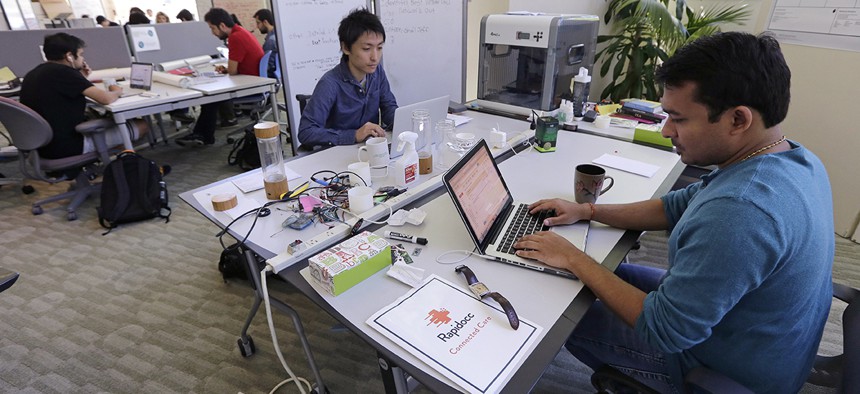Trump Is Quietly Swamping Visa Applicants in Extra Paperwork

Babson College graduate school alumnus and Visa applicant Abhinav Sureka, of Mumbai, India, right, types in his work space at the college in Wellesley, Mass. Charles Krupa/AP
The H-1B visa allows American companies to hire skilled foreign workers.
The H-1B visa, which allows American companies to hire skilled foreign workers, from engineers to fashion models, is under siege.
Last year, Trump’s “Buy American and Hire American” executive order suggested that H-1Bs should be more difficult to get. Congress and the Trump administration have been mulling ways to limit the visa’s availability to Indian workers. But obtaining an H-1B visa has already quietly become more cumbersome since Donald Trump became president, not through any change in the law, but through bureaucracy.
One indicator of that is a spike in “requests for evidence,” which are notices the US Citizen and Immigration Services department sends to H-1B applicants requesting more information. Such requests, known as RFEs, are a routine part of the visa process. Their purpose is to ensure that the agency (USCIS) only grants visas to people who meet the criteria. But lawyers who represent H-1B applicants say they are now getting unwarranted requests, and in bigger numbers, than in the past.
The data back their claims, at least in terms of volume. From last January to November, the office issued around 40% more RFEs than in all of 2016, and 65% more than in all of 2015, USCIS data shows.
The increase in RFEs should assuage critics of the program, who have long complained H-1Bs are a way for employers to import cheap labor at the expense of American workers.
For those awaiting work permits and the companies wanting to hire them, an RFE is bad news. While it doesn’t necessarily derail a petition, it makes the process longer and more expensive. Rounding up the documents to address USCIS concerns, submitting them, and awaiting an answer can take two to three months, says Diane Rish, associate director of government relations at the American Immigration Lawyers Association.
Some members of Rish’s association report that they’ve gotten a second RFE after completing the first one. Many of them complain the mounting level of scrutiny is “unjustified and unnecessary,” she says, given the extensive vetting already built into the USCIS system.
USCIS says it has been asking for evidence in more cases, and for second RFEs in some cases. “We understand that RFEs can cause delays, but the added review and additional information gives us the assurance we are approving petitions correctly,” USCIS director Francis Cissna said in a statement. “Increasing our confidence in who receives benefits is a hallmark of this administration and one of my personal priorities.”
He also points out that the number of RFEs issued in 2017 alone can be misleading, because they also include challenges to petitions filed before that year. A better measure of how often officials issue RFEs, according to him, is the share of cases completed in a given period that triggered a notice. That rate for fiscal 2017 was around 20%, close to levels in 2015 and 2016. But the data also show that it doubled to 40% in the first couple of months of fiscal 2018. That could mean rates had held steady for a while simply because the slew of 2017 RFSs took a while to show up in completed cases. The trend will become clearer in coming months.
H-1B hopefuls will also be watching approval rates. USCIS approved more than 90% of the H1B applications it processed in fiscal 2017, but that rate dipped below 85% in the first two months of fiscal 2018.





